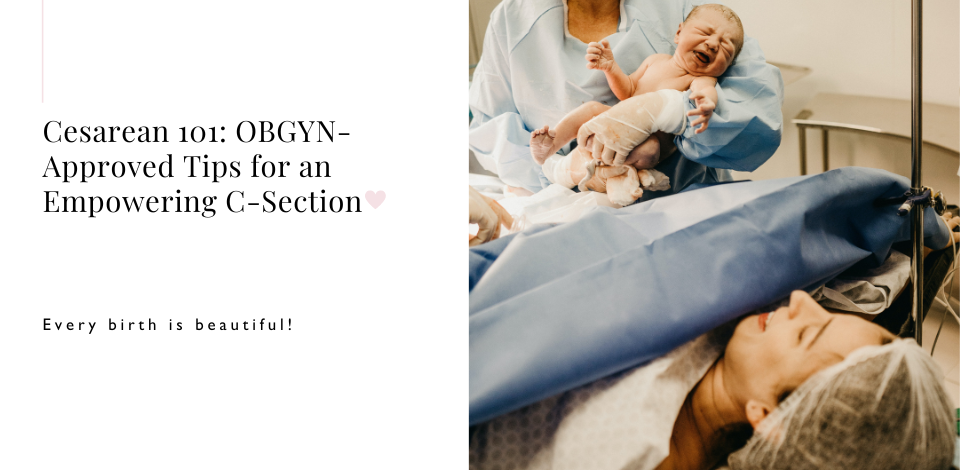Cesarean 101: OBGYN-Approved Tips for an Empowering C-Section
Jump to Section

Every birth story is different and every birth story is beautiful. If you’re currently expecting, you probably have a vision of exactly how you want your labour and delivery to go — and it likely doesn’t include a C-section. Sometimes it feels like there is a stigma surrounding cesarean delivery, and certainly a lot of trepidation about an unplanned or emergency C-section.
If you’re ready for a deep dive into what happens during and after cesarean delivery, make sure to check out Season 2, Episode 8 of our 40 Weeks to Forever podcast, as OBGYN Dr. Kelly Strode answers all our questions on this topic.
Dr. Strode is a specialist currently at Guelph Obstetrics and Gynecology, a clinic in Ontario that offers preconception, prenatal, and postpartum care. Dr. Strode mentions that many parents-to-be focus their research on a vaginal birth, which can lead to confusion and/or fear if an emergency c-section is required. In this article, we’re going to take you through some of Dr. Strode’s most important advice to ensure that you are ready to have an empowering cesarean delivery.
What Actually Happens During a C-Section?
The entire cesarean delivery process takes about 45 minutes to an hour. This will depend on whether the operation is planned or not, as well as any complications that may arise during the procedure.
Preparation includes:
- Ingesting preoperative antibiotics
- Establishing anesthesia placing the catheter
- Cleaning the belly through antiseptics
Closing things up usually takes a bit longer than the opening part because your doctors will be watching the bleeding and making sure everything gets back in the right place. After this, you’ll be transferred to the recovery room if no complications arise.
Depending on where you’re giving birth, you could have up to two support people present. However, this could change depending on your individual situation (for example, if a general anesthetic is required). If this is the case, the partner or support person should be able to enter the room once the baby has emerged.
Planning for the Unexpected
There are many different reasons why a patient might have a cesarean birth (you can listen to the full episode for a comprehensive list), but the key thing to keep in mind is that labour and delivery can be unpredictable. Even if you have a vaginal birth in mind, you should still consider what to do if a c-section is required.
It is important to discuss the possibility of a C-section with your partner and health care team, just so you know what to expect and don’t forget to add an emergency c-section component in your birthing plan — you may not have time (or presence of mind) to communicate that with your OBGYN in the moment.
If you’re planning your cesarean delivery, it is worth talking about some elements that may make you feel more at ease before, during, and after the procedure. Many birthing centres will accommodate your requests to personalize the space with things like special lights or calming music on a personal speaker. You might also want to request a more in-depth conversation with the anesthesiologist to ensure you’re feeling comfortable and safe during the delivery.
As you make your plan, keep in mind that in an emergency situation:
- You might not have the time to get comfortable with the anesthetic
- Your support person will not be allowed in the operating room
- Delayed cord clamping can be challenging in emergency cases
- Skin-to-skin contact between the mother and infant during an emergency caesarian is slightly more complicated
Postpartum Care & Healing
Many moms-to-be are worried about scarring and other elements of the postpartum recovery from a C-section. Thanks to medical advancements, cesarean incisions are now only slightly larger than necessary to remove the baby's head, this means scarring is minor and unobtrusive (and it doesn’t make a difference if you receive stitches or staples to close the incision).
Care for the healing incision is relatively simple and straightforward:
- Don’t immerse the wound in water — so no swimming or sitting in a tub until the skin heals fully
- Keep the incision clean and exposed to air for the first 4–6 weeks. Applying ointments to the incisions is not advised except in the case of an infection that may require topical antibiotics.
- Once the incision is healed (edges together, no raw areas), gentle massage can help nerve connections re-establish and minimize the appearance of the scar.
Final Thoughts
Be sure to check out Season 2, Episode 8 of our 40 Weeks to Forever podcast for more information on cesarean delivery and recovery.
When It Doesn’t Go As Planned
Guest: Dr. Kelly Strode
